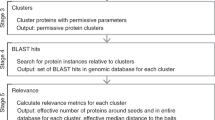Abstract
The utilization of metagenomic functional interactions represents a key technique for metagenomic functional annotation efforts. By definition, metagenomic operons represent such interactions, but many operon predictions protocols rely on information about orthology and/or gene function that is frequently unavailable for metagenomic genes. Recently, the concept of the metagenomic proximon was proposed for use in metagenomic scenarios where supplemental information is sparse. In this paper, we examine the validity and utility of the proximon proposition by measuring the extent to which proximons emulate actual operons. Using the Escherichia coli K-12 genome, we compare proximons and operons from the same genome and observe the configurations and cardinalities among their corresponding mappings. The results demonstrate that the vast majority of proximons map discretely to a single operon in a conservative fashion where a typical proximon is synonymous to an equivalent or truncated operon. However, a large proportion of operons had no corresponding mappings to any proximon. Various perspectives of operon and proximon intersection are discussed, along with the potential limitations for proximon detection and usage.






Similar content being viewed by others
References
Altschul SF, Gish W, Miller W, Myers EW, Lipman DJ (1990) Basic local alignment search tool. J Mol Biol 215:403–410
Aravind L (2000) Guilt by association: contextual information in genome analysis. Genome Res 10:1074–1077
De Filippo C, Ramazzotti M, Fontana P, Cavalieri D (2012) Bioinformatic approaches for functional annotation and pathway inference in metagenomics data. Brief Bioinform 13:696–710
Jacob F, Monod J (1961) Genetic regulatory mechanisms in the synthesis of proteins. J Mol Biol 3:318–356
Janga SC, Moreno-Hagelsieb G (2004) Conservation of adjacency as evidence of paralogous operons. Nucleic Acids Res 32:5392–5397
Kagan J, Sharon I, Beja O, Kuhn JC (2008) The tryptophan pathway genes of the Sargasso Sea metagenome: new operon structures and the prevalence of non-operon organization. Genome Biol 9(1):R20
Liu B, Pop M (2011) MetaPath: identifying differentially abundant metabolic pathways in metagenomic datasets. BMC Proc 5:S9
Miller JH, Reznikoff WS (1978) The operon. Cold Spring Harbor Laboratory, New York
Moreno-Hagelsieb G, Collado-Vides J (2002a) A powerful non-homology method for the prediction of operons in prokaryotes. Bioinformatics 18:S329–336
Moreno-Hagelsieb G, Collado-Vides J (2002b) Operon conservation from the point of view of Escherichia coli, and inference of functional interdependence of gene products from genome context. In Silico Biol 2:87–95
Moreno-Hagelsieb G, Janga SC (2008) Operons and the effect of genome redundancy in deciphering functional relationships using phylogenetic profiles. Proteins 70:344–352
National Center for Biotechnology Information (2014) FTP directory of bacterial genomes. ftp://ftp.ncbi.nih.gov/genomes/Bacteria/
Oliver S (2000) Guilt-by-association goes global. Nature 403:601–603
Rhee SY, Mutwil M (2014) Towards revealing the functions of all genes in plants. Trends Plant Sci 19:212–221
Salgado H, Moreno-Hagelsieb G, Smith TF, Collado-Vides J (2000) Operons in Escherichia coli: genomic analyses and predictions. Proc Natl Acad Sci U S A 97:6652–6657
Salgado H, Peralta-Gil M, Gama-Castro S, Santos-Zavaleta A, Muñiz-Rascado L et al (2013) RegulonDB v8.0: omics data sets, evolutionary conservation, regulatory phrases, cross-validated gold standards and more. Nucleic Acids Res 41:D203–D213
Taboada B, Verde C, Merino E (2010) High accuracy operon prediction method based on STRING database scores. Nucleic Acids Res 38:e130
Vey G (2013) Metagenomic guilt by association: an operonic perspective. PLoS ONE 8:e71484
Vey G, Charles TC (2014) MetaProx: the database of metagenomic proximons. Database (Oxford). 2014: bau097
Vey G, Moreno-Hagelsieb G (2010) Beyond the bounds of orthology: functional inference from metagenomic context. Mol BioSyst 6:1247–1254
Vey G, Moreno-Hagelsieb G (2012) Metagenomic annotation networks: construction and applications. PLoS ONE 7:e41283
Acknowledgments
This work was supported by a Natural Sciences and Engineering Research Council of Canada Strategic Grant. The authors thank Gabriel Moreno-Hagelsieb of Wilfrid Laurier University for conversations about metagenomic operons.
Author information
Authors and Affiliations
Corresponding author
Rights and permissions
About this article
Cite this article
Vey, G., Charles, T.C. An analysis of the validity and utility of the proximon proposition. Funct Integr Genomics 16, 215–220 (2016). https://doi.org/10.1007/s10142-016-0478-z
Received:
Revised:
Accepted:
Published:
Issue Date:
DOI: https://doi.org/10.1007/s10142-016-0478-z




